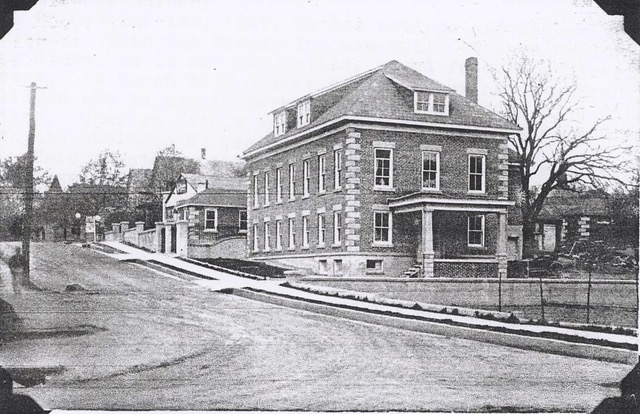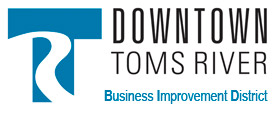
(c. 1916) [9 Robbins St.]
The H. Clay Glover Company was founded in 1876 by its namesake, Dr. Henry Clay Glover (1845-1914), in New York City. Dr. Glover was a veterinary surgeon (V.S.) who patented, formulated, produced, and sold one of the most extensive U.S. patented lines of veterinary medicines primarily for dogs and other animals. He gained initial and long-term success with his popular Glover’s Dog Mange Cure and was the recipient of the Medal of Superiority by the American Institute of New York.
Mange is an infectious skin disease that causes severe itching, hair loss, and the formation of scabs and wounds all over the tormented animal’s body. Dr. Glover raised Irish setters and was a veterinarian and a show judge for the Westminster Kennel Club in the late 1880s and early 1890s. He lived in New York City and had offices and factories there and in the small village of Toms River, New Jersey.
Glover’s Mange Cure was a product formulated as a result of a partnership between Charles B. Mathis (1844-1929), a Toms River druggist, and Dr. Glover. Their partnership grew possibly from a chance meeting in downtown Toms River in 1876. Glover was a frequent visitor to the Silverton area of the town. Mathis was also a dog enthusiast. Perhaps their mutual interest drew them to make an important, life-altering connection. They decided to work together to develop a cure for mange disease. Mathis formulated the successful treatment which was eventually sold worldwide. It was marketed as Glover’s Imperial Mange Cure (later Remedy) and sold for 50 cents per bottle. For many years, Mathis mixed and bottled the cure in his store at the southeast corner of Main and Water Streets. The two partners agreed to market and sell the product in New York City. Glover incorporated his company in Manhattan, N.Y. but prepared the remedy in the small downtown village of Toms River, N.J.
Eventually, Glover’s success with selling the product forced the two partners to move production to a building on Water Street in 1887. During this time, Dr. Glover formulated 27 other products for treating various canine illnesses. Some of these, along with his famous remedy for mange, were mass-produced. As demand grew, so did the need for more factory space. Dr. Glover died in 1914, two years before the H. Clay Glover Company relocated and built a new three-story brick building with a basement on a lot at the corner of East Water Street and Robbins Street. Mathis’s son, Harry C. Mathis, was general manager of the Toms River factory for many years.
By today’s standards, the early manufacturing processes used to produce the mange cure were rather crude. It was prepared in wooden tanks and flowed from one station to the next in troughs also made of wood. Bottles were filled entirely by hand, as was corking, hot wax sealing, labeling, and crating the product. Then, it was transported by horse and wagon to a nearby rail-siding for shipment to New York City, Chicago, and St. Louis. Local workers were paid $10 per week, including a half-day on Saturday. A fire in 1944, gutted the factory and a temporary site was established in Seaside Heights while the Robbins Street facility was rebuilt and reopened in 1945. Later, from 1968 through its closing in 1993, chemist, businessman and beloved philanthropist, Joseph P. Knipper of J. Knipper Pharmaceuticals, became the vice-president and a trustee of the H. Clay Glover Company. He oversaw the Toms River factory operations and management.
The Glover Building was listed for sale in 1991 when manufacturing operations were consolidated to J. Knipper & Co., Lakewood, N.J. The 12,000 square-foot, three-story brick factory featured three glass and iron framed skylights, a steel staircase, a freight elevator, stone quoining, 15’ vaulted ceilings, and banks of windows facing historic Huddy Park and the Toms River. It caught the eye of a prominent and longtime businessman of Toms River, Stephan R. Leone, Esq. and his wife Judith Gibson Leone. The Glover Factory was still operating as a distribution point with a handful of local, dedicated employees up until Mr. Leone’s purchase of the property in December 1993.
Mr. and Mrs. Leone, along with their design and construction team, architect, Robert M. Fania, professional engineer, Stuart C. Challoner, and two daughters, Cheryl A. Leone and Debra Leone Challoner, combined the preservation of industrial design and Federalist style architectural features. Their community spirit breathed contemporary entrepreneurial life into this significant downtown Toms River historical landmark.
Today, 9 Robbins Street serves as the home of Mr. Leone’s law firm: Carluccio, Leone, Dimon, Doyle & Sacks, L.L.C. and the real estate development office of Leone & Daughters Realty Management Corp. where Mr. Leone and his daughter Debra Leone Challoner work in adjacent offices on the 2nd floor. Occasionally, on a very hot and sunny afternoon, when the sun bakes the brick on the west façade, you can detect the slight odor of pine tar in the northwest stairwell, a key ingredient of Glover’s Imperial Mange Cure.
